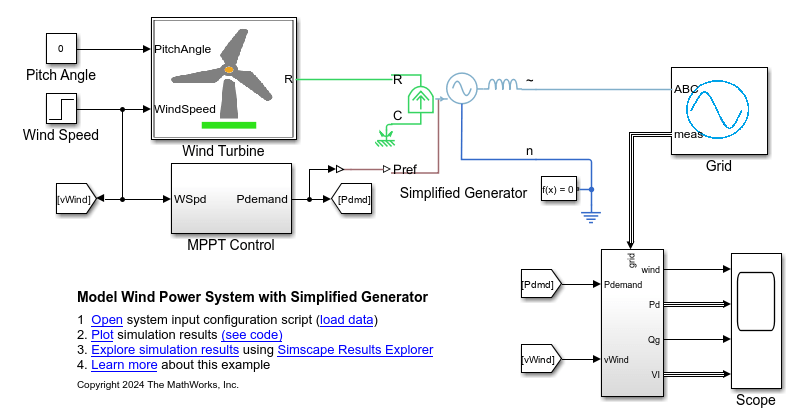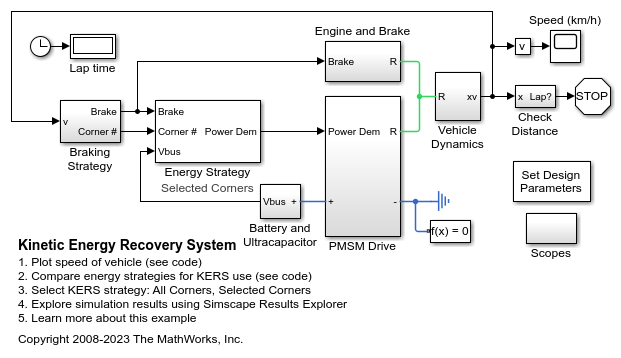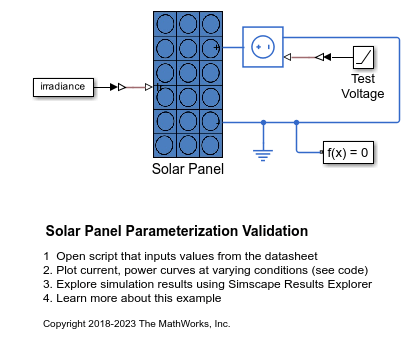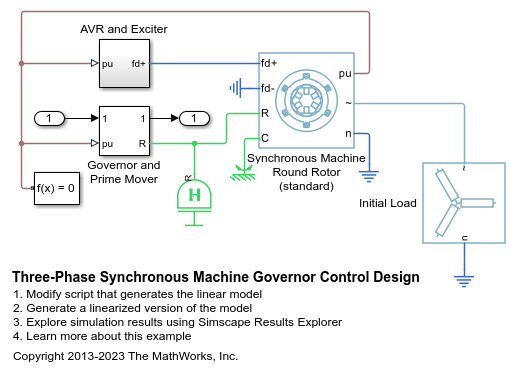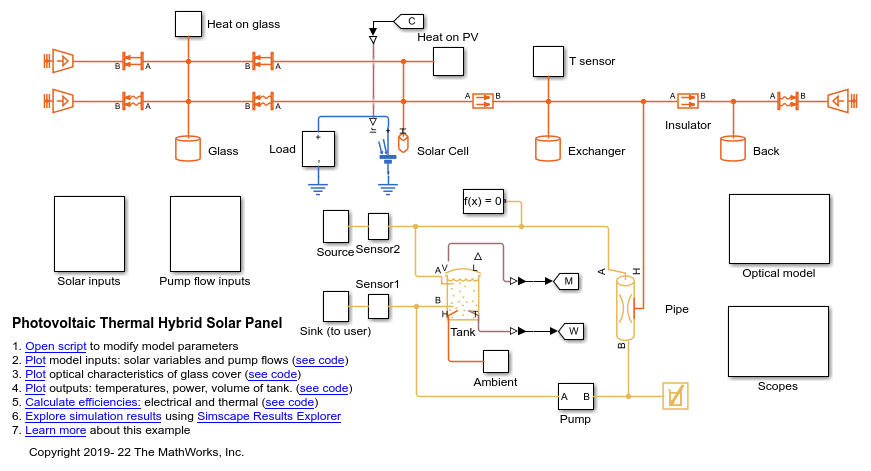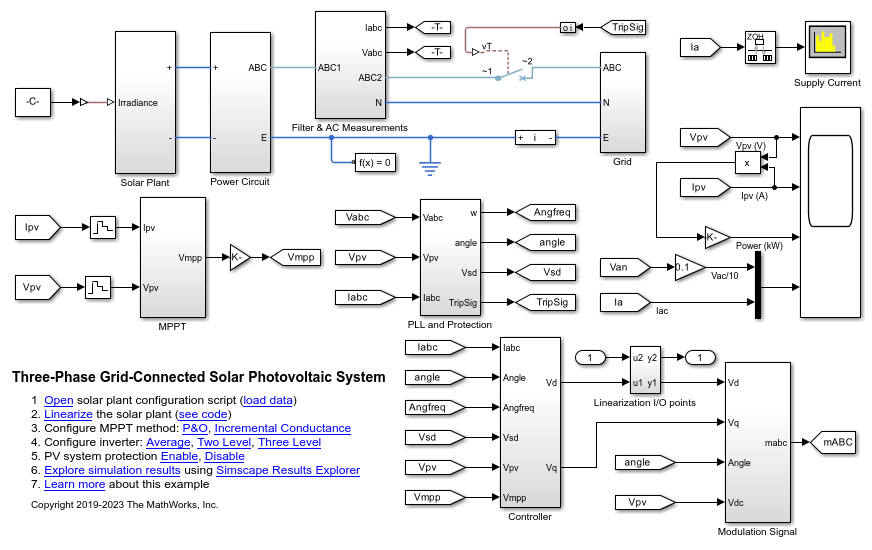可再生能源
利用这些示例了解如何对光伏系统和风能系统及发电机进行建模。
精选示例
Control Three-Phase Solar Inverter
Control a three-phase single-stage solar photovoltaic (PV) inverter using a Solar PV Controller (Three-Phase) block. In a grid-connected PV plant, a PV controller extracts the maximum power from the solar array and feeds it to the grid. To extract the maximum available PV power, the controller uses a maximum power point tracking (MPPT) algorithm.
- 自 R2025a 起
- 打开实时脚本
使用简化发电机对风力发电系统进行建模
此示例展示了如何使用 Simplified Generator 模块对一个低保真度的三相并网风力发电系统进行建模。可使用此低保真度电气模型进行规划和变桨控制研究。
- 自 R2024b 起
- 打开实时脚本
Evaluate Performance of Grid-Forming Battery Energy Storage Systems in Solar PV Plants
Evaluate the performance of a grid-forming (GFM) battery energy storage system (BESS) in maintaining a stable power system with high solar photovoltaic (PV) penetration. You can evaluate the power system during both normal operation or contingencies, like large drops in PV power, significant load changes, grid outages, and faults. You can download this model in MATLAB® or access it from MATLAB Central File Exchange and GitHub®.
- 自 R2023b 起
- 打开实时脚本
Energy Scavenger
How the performance of a rotational energy scavenger can be explored using a simple representative model. Electrical energy is produced from an off-center mass attached to the shaft of a DC motor. The mass, geometry, motor and electrical parameters must be matched to the expected mechanical excitation. The generated electrical power is less than the extracted mechanical power primarily due to motor winding losses and viscous damping for the rotor. This example is based on Nunna, K. "Constructive interconnection and damping assignment passivity-based control with applications", Imperial College London (2014). The model here is simplified in that the DC-DC converter is omitted.
Kinetic Energy Recovery System
Operation of a Kinetic Energy Recovery System (KERS) on a Formula 1 car. The model permits the benefits to be explored. During braking, energy is stored in a lithium-ion battery and ultracapacitor combination. It is assumed that a maximum of 400KJ of energy is to be delivered in one lap at a maximum power of 60KW. Design parameters are the weight of the battery, ultracapacitor and motor-generator. If these parameters are all set to the very small value of 0.01kg, the lap time is 95.0 seconds, this corresponding to a car with no KERS. With default values set here, approximately 1/4 of a second is saved on the lap time when using any available electrical power when not braking. Applying KERS only to selected corners requires a larger ultracapacitor to show any significant benefit.
Photovoltaic Generator
Create system-level model of a photovoltaic generator that can be used to simulate performance using historical irradiance data. Here the model is tested by varying the irradiance which approximates the effect of varying cloud cover. Power generation steps immediately following the irradiance change. Environmental temperature also varies during the test. The DC-AC converter efficiency is assumed to be a fixed 97 percent, this value having been determined from the SolarPowerInverter example model.
太阳能电池功率曲线
此示例展示了如何生成太阳能电池阵列的功率-电压曲线。理解功率-电压曲线对于逆变器设计至关重要。理想情况下,在给定辐照度水平和电池板温度下,太阳能电池阵列应始终以峰值功率运行。
Solar Panel Parameterization Validation
Model a solar panel by using data from a manufacturer datasheet. This example uses the datasheet data to generate current-voltage and power-voltage curves for the solar panel. The power-voltage curve helps you identifying the peak power for a given irradiance level and panel cell temperature. This peak power is then useful when designing an inverter.
Three-Phase Synchronous Machine Governor Control Design
Script shows how you can linearize a Simscape™ Electrical™ model to support control system stability analysis and design. It uses example model SMGovernorDesign.
Photovoltaic Thermal (PV/T) Hybrid Solar Panel
Model a multi-domain power cogeneration system using Simscape™, Simscape Electrical™, and Simscape Fluids™.
Single-Phase Grid-Connected Solar Photovoltaic System
Model a rooftop single-phase grid-connected solar photovoltaic (PV) system. This example supports design decisions about the number of panels and the connection topology required to deliver the target power. The model represents a grid-connected rooftop solar PV system without an intermediate DC-DC converter. To parameterize the model, the example uses data from a solar panel manufacturer datasheet. Solar power is injected into the grid with unity power factor (UPF).
Three-Phase Grid-Connected Solar Photovoltaic System
Model a three-phase grid-connected solar photovoltaic (PV) system. This example supports design decisions about the number of panels and the connection topology required to deliver the target power. The model represents a grid-connected rooftop solar PV system without an intermediate DC-DC converter. To parameterize the model, the example uses data from a solar panel manufacturer datasheet. Solar power is injected into the grid with unity power factor (UPF).
Solar PV System with MPPT Using Boost Converter
The design of a boost converter for controlling the power output of a solar photovoltaic (PV) system. In this example, you learn how to:
Stand-Alone Solar PV AC Power System with Battery Backup
The design of a stand-alone solar photovoltaic (PV) AC power system with battery backup. In this example, you learn how to:
Stand-Alone Solar PV DC Power System with Battery Backup
The design of a stand-alone solar photovoltaic (PV) DC power system with battery backup. In this example, you learn how to:
Piezo Bender Energy Harvester
Model a device that harvests energy from a vibrating object by using a piezo bender. The device uses this energy to charge a battery and power a load. These devices are common in low-power applications that require energy autonomy, such as wearable devices or sensors in vehicles.
Analysis of Solar Photovoltaic System Shading
Implement shading effects in a solar photovoltaics (PV) plant or module. The solar plant block is created using Simscape™ language. Shading in a solar plant or module occurs when solar irradiance is not uniform across all solar PV modules or cells. You can use this example to study the effects of shading and PV cell junction temperature in a large interconnected solar plant or a single PV module. To improve the maximum power and to protect the solar panel from overheating, the Solar Plant block comprises bypass and blocking diodes. To define the shading, set the values of the Irradiance and Temperature parameters.
绿色氢能微网
此示例展示了一个 DC 孤岛微网,该微网利用太阳能电池阵列和储能系统为电解槽供电。您可以使用该模型评估在 7 天时间内,仅通过太阳能电池阵列供电,或通过太阳能电池阵列与储能系统组合供电来生产绿色氢能的运行特性。该模型包含电气域、热液体域和热气体域。
Wind Turbine
Model, parameterize, and test a wind turbine with a supervisory, pitch angle, MPPT (maximum power point tracking), and derating control. When you run the plot function, it generates a plot of the state transitions, normalized physical quantities such as the wind speed, wind turbine rotation speed, generator power, and pitch angle.
MATLAB Command
You clicked a link that corresponds to this MATLAB command:
Run the command by entering it in the MATLAB Command Window. Web browsers do not support MATLAB commands.
选择网站
选择网站以获取翻译的可用内容,以及查看当地活动和优惠。根据您的位置,我们建议您选择:。
您也可以从以下列表中选择网站:
如何获得最佳网站性能
选择中国网站(中文或英文)以获得最佳网站性能。其他 MathWorks 国家/地区网站并未针对您所在位置的访问进行优化。
美洲
- América Latina (Español)
- Canada (English)
- United States (English)
欧洲
- Belgium (English)
- Denmark (English)
- Deutschland (Deutsch)
- España (Español)
- Finland (English)
- France (Français)
- Ireland (English)
- Italia (Italiano)
- Luxembourg (English)
- Netherlands (English)
- Norway (English)
- Österreich (Deutsch)
- Portugal (English)
- Sweden (English)
- Switzerland
- United Kingdom (English)

